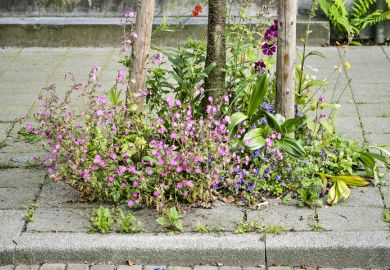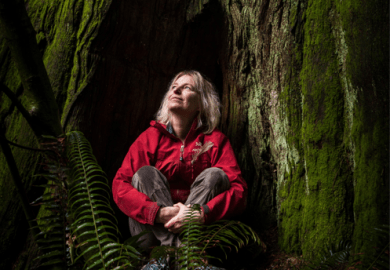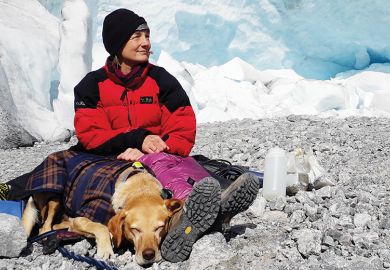Why are there no active volcanoes in Hampshire? And why do earthquakes always seem to hit foreign climes (especially popular holiday destinations in the Adriatic) instead of Margate? Can rocks affect your health? With more than 900 entries, from acid rain to zoogeomorphology, "the study of geomorphical effects of animals, including both vertebrates and invertebrates", The Oxford Companion to the Earth has the answers. What is more, with words such as jokulhlaup, yardang and tafoni, you are guaranteed to keep your Travel Scrabble score well above average for years to come. The entries are provided by an impressive list of 266 contributors, including experts from academe and industry. They provide the bulk of the text, with many of the longer entries accompanied by suggestions for further reading. An appendix in four sections covers geological time scales, the Earth and solar system, the periodic table and scientific units, abbreviations and conversions, and this is followed by a thematic list and a comprehensive index running to 22 pages.
The aim of Oxford Companions as a series is to provide concise and readable accounts of subject areas for the professional and general reader, and the scope of the present work is deliberately wide. It is concerned not only with the solid Earth (the lithosphere), but with the entire planetary environment on which living organisms depend, including the atmosphere, hydrosphere and biosphere. Along with better-known topics such as volcanology, palaeontology, earthquakes and geomorphology are more exotic entries, including Atlantis, ecclesiastical geology and mythology in the Earth sciences.
The companion is not just a straightforward dictionary. When the book arrived, I was looking for information on an idea for a research project on pingos (underground ice intrusions). But turning to the section beginning with P - oh dear, no pingos. My first use of the companion in a professional capacity drew a blank. In fact, pingos are, quite sensibly, featured under the entry on periglacial landscapes.
I imagine the amount of work involved in collating a volume such as this must have been colossal; and as the entries will be only as good as the work put in by hard-pressed individual contributors, who are likely to receive little recognition from their peers for time spent in an activity that has no value on a research assessment exercise return, there is a small but finite risk of failure. Who wants to hang around with a mediocre companion? Much of the book's success is due to the commitment of Paul Hancock, the original editor-in-chief, an expert in structural geology and neo-tectonics, who helped set the project in motion and convince fellow scientists of its worth. On his untimely death, editorial responsibility was handed over to Brian Skinner at Yale University, who, along with four associate editors, supervised the project to completion.
And so to the entries themselves. They fall into three classes: technical, historical and bibliographical. I was drawn to a number of fascinating erudite entries by David Dineley, emeritus professor at Bristol University and an associate editor of the companion, on earth sciences and the arts. It is a relationship worthy of further exploration and development. The entry on music and earth sciences in particular caught my fancy. That artists and composers (especially in the West), have long drawn inspiration from the atmosphere, oceans and landscape is well known, but what about nature's self-made music? The singing sands of Arabia, North America and parts of the United Kingdom, whose booming and wailing sounds result from the rubbing together of countless grains, or "lithophones" - percussion instruments of great antiquity that when cut to differing lengths and hit with wooden hammers ring like bells? Indeed, anyone in the vicinity of 21 Old Bond Street in London in the 1840s could have whiled away an afternoon in the company of Mr J. Richardson's three sons and five chromatic octaves of metamorphosed Skiddaw slate that was the Rock Harmonicon. Played on two occasions before Queen Victoria, it is preserved today in a Keswick museum. A variant, known as the Steinspiel , features in several works by Carl Orff.
In a welcome contribution, Ted Nield, science and communications officer for the Geological Society of London, reviews the relationship between geoscience and the media. Exactly how much coverage do the earth sciences receive as a percentage of all science coverage? Not much, according to a review by the Novartis Foundation's Media Resource Centre, where just 1.8 per cent of calls from UK journalists were for information about earth sciences, compared with 39 per cent about health and medicine. However, reliable information on stories that are not simply motivated by events (expert opinion in response to some natural disaster) is lacking. What with the recent interest in giant tsunamis, new dinosaur discoveries in China and potential asteroid impacts, along with the constant debate on global climatic change and the recent spate of flooding, the true figure is likely to be much higher.
But a major problem lies in convincing scientists to tell the world all about it. There is still suspicion of the media in some quarters, and also cynicism about engaging in the public understanding of science. Others still labour under the naive assumption that the media's prime aim is to educate (as opposed to entertain) - an attitude that often leads to trouble. The truth is, as revealed in a recent Wellcome Trust-Office of Science and Technology report into public attitudes to science, that while scientists are admired for their work by the layman, these feelings among the public are not much reciprocated among scientists.
The entry on geological humour brought back some memories. I still recall laughing out loud on the first day of my first geological field trip, on a rainy October morning at Dawlish, when told to draw the side of a sodden railway cutting "paying particular attention to the internal stratification and grain-size variations". Unfortunately, the lecturer was not joking. Less funny, though based on a similar feeling, is a Punch cartoon to be found under the entry on amateurs in geology: it shows a couple of bemused-looking ramblers asking a bearded geologist for directions and being told to "follow the Lower Greensand until you strike the Gault Clay, then turn left along the outcrop of calcareous grit and you'll see Little Gadhurst right there on the chalk escarpment". Hardly Perrier award-winning stuff, but it makes the point that even today some (including professional scientists) still regard geologists as tweed-clad fossil collectors. While there is indeed a lively amateur trade in fossil and mineral specimens, with regular meetings and fairs across the country where enthusiasts meet to swap and sell their wares, the subject has moved on in ways that the field-based founding practitioners could never have dreamt. Today, inductively coupled laser mass spectrometers and Beowulf clusters running under Linux operating systems are the preferred route to a fellowship of the Royal Society.
The companion also highlights some close links between geology and the military. Take, for example, Brigadier Ralph Alger Bagnold (1896-1990), a professional soldier who became famous academically for his pioneering work on the physics of sediment transport in fluids, especially wind-blown sand. His interest, which developed during a posting to Egypt in the interwar years, was put to practical use in the war during the North African campaign, in which Bagnold used his knowledge of sand and desert environments to harass the enemy with his Long Range Desert Group.
Wine and geology (as opposed to geologists who whine) make for interesting reading, even if the subject is a little contrived. It is a truism that soil composition is a dominant factor in the growth of vegetation, but the ideal vineyard setting depends too on the physical geology of a region, its valleys and slope angles. It is intriguing that granitic and volcanic soils occur in many wine-producing regions including Beaujolais and Sardinia, and I feel that detailed research is needed in this important area, so as to link more closely rock composition with wine properties including flavour, colour and flow properties.
Modern geology became established in Europe in the 18th century. The first chair in geology in England was the Woodwardian chair, founded in 1728 at Cambridge University. The Geological Society of London (the oldest geological society in the world) was founded 79 years later in 1807. However, intellectual curiosity and writings on aspects of the earth sciences can be traced back to antiquity. The reader will find sections on the beginning of geological thought, the history of geology and the philosophy of geology. These entries draw on the classic F. D. Adams text, The Birth and Development of the Geological Sciences (still in print through Dover Publications), and for anyone interested in the history of geology and the earth sciences, this book is a must.
Many of the more influential characters from antiquity to recent times (such as Aristotle, Darwin and Hutton) have their rightful entries in the companion, but Lucretius, although mentioned in passing in several entries, deserves to be included in his own right. Where would you find a better account of erosion and rock weathering than in his De Rerum Natura : "Again, do you not see that stones even are conquered by time, that tall turrets do fall and rocks do crumble, that the gods' temples and their images wear out and crack."
Deciding what to include and leave out is a tall order, which in the final resort is down to the editor's preference. Personally, I am pleased to see Jonathan Turner's entry on Gaia and very glad not to see under the entry on diapirism cartoons of the hackneyed "inverted granite teardrop" making its way upwards towards an unsuspecting surface. However, I would like to see entries on dilatancy, granular flow and confocal microscopy in any revised edition. And how long the companion stays current, especially the sections on planetary geology when every day brings new data to Earth from orbiting space probes, is anyone's guess. But then, that is the sign of a vibrant discipline.
All in all, the editors of and contributors to The Oxford Companion to the Earth have produced an enjoyable, informative and entertaining reference book destined to become the friend of the professional and amateur alike.
Nick Petford is reader in earth sciences, Kingston University.
The Oxford Companion to the Earth
Editor - Paul L. Hancock and Brian J. Skinner
ISBN - 0 19 854039 6
Publisher - Oxford University Press
Price - £39.50
Pages - 1,174
Register to continue
Why register?
- Registration is free and only takes a moment
- Once registered, you can read 3 articles a month
- Sign up for our newsletter
Subscribe
Or subscribe for unlimited access to:
- Unlimited access to news, views, insights & reviews
- Digital editions
- Digital access to THE’s university and college rankings analysis
Already registered or a current subscriber? Login



